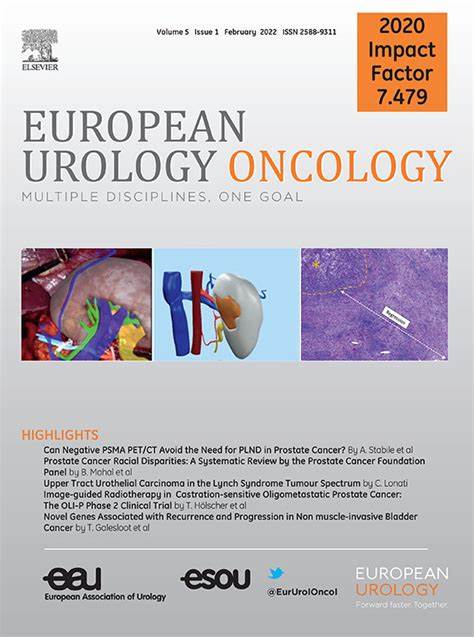Cabozantinib plus Pembrolizumab as First-line Therapy for Cisplatin-ineligible Advanced Urothelial Carcinoma: The PemCab Trial
IF 9.3
1区 医学
Q1 ONCOLOGY
引用次数: 0
Abstract
Background and objective
Pembrolizumab monotherapy is approved for patients with platinum-ineligible metastatic urothelial carcinoma (mUC). Cabozantinib is a multireceptor tyrosine kinase inhibitor with activity against MET and VEGFR2 and is approved as monotherapy or in combination with a PD-1 inhibitor for other malignancies. The objective was to determine the safety and efficacy of pembrolizumab + cabozantinib as first-line treatment for patients with mUC.
Methods
In this open-label, single-arm, multicenter, phase 2 study, patients received pembrolizumab 200 mg every 3 wk + cabozantinib 40 mg daily. Key inclusion criteria were locally advanced UC or mUC, Eastern Cooperative Oncology Group performance status 0–2, ineligible for or refused cisplatin, and no prior PD-1/L1 inhibitor. The primary endpoint was the objective response rate (ORR). Secondary endpoints included progression-free survival (PFS) and overall survival (OS). According to the statistical plan, in a cohort of 35 evaluable participants, the lower bound of the 95% confidence interval (CI) would extend no more than 26% from the ORR observed, and in a scenario with ≥17 objective responses, the CI would exclude 32%.
Key findings and limitations
Responses were observed in 16 of 35 evaluable patients, with an ORR of 46% (95% CI 31–62%). Median PFS and OS were 8 mo (95% CI 5-13) and 17 mo (95% CI 13–not reached), respectively. The most common treatment-emergent adverse events (any grade) were diarrhea (58%), fatigue (56%), pruritus (39%), nausea (36%), palmar-plantar erythrodysesthesia (36%), and a decrease in appetite (33%).
Conclusions and clinical implications
This phase 2 trial of pembrolizumab + cabozantinib demonstrated a manageable toxicity profile and promising efficacy as a first-line therapy combination for cisplatin-ineligible patients with mUC.
卡博赞替尼联合派姆单抗作为顺铂不合格晚期尿路上皮癌的一线治疗:PemCab试验
背景和目的:Pembrolizumab单药治疗被批准用于治疗铂不符合条件的转移性尿路上皮癌(mUC)。Cabozantinib是一种多受体酪氨酸激酶抑制剂,具有抗MET和VEGFR2的活性,被批准用于其他恶性肿瘤的单药治疗或与PD-1抑制剂联合治疗。目的是确定派姆单抗+卡博赞替尼作为mUC患者一线治疗的安全性和有效性。方法:在这项开放标签、单臂、多中心、2期研究中,患者接受派姆单抗200mg / 3周+卡博赞替尼40mg /天的治疗。主要入选标准为局部晚期UC或mUC,东部肿瘤合作组织(Eastern Cooperative Oncology Group)的表现状态为0-2,不适合或拒绝顺铂治疗,既往无PD-1/L1抑制剂。主要终点为客观缓解率(ORR)。次要终点包括无进展生存期(PFS)和总生存期(OS)。根据统计计划,在35名可评估参与者的队列中,95%置信区间(CI)的下界将从观察到的ORR延伸不超过26%,在客观反应≥17的场景中,CI将排除32%。主要发现和局限性:35例可评估患者中有16例出现反应,ORR为46% (95% CI 31-62%)。中位PFS和OS分别为8个月(95% CI 5-13)和17个月(95% CI 13-未达到)。最常见的治疗不良事件(任何级别)是腹泻(58%)、疲劳(56%)、瘙痒(39%)、恶心(36%)、手掌-足底红肿(36%)和食欲下降(33%)。结论和临床意义:这项pembrolizumab + cabozantinib的2期临床试验显示,pembrolizumab + cabozantinib作为顺铂不合格mUC患者的一线治疗组合具有可控的毒性和有希望的疗效。
本文章由计算机程序翻译,如有差异,请以英文原文为准。
求助全文
约1分钟内获得全文
求助全文
来源期刊

European urology oncology
Multiple-
CiteScore
15.50
自引率
2.40%
发文量
128
审稿时长
20 days
期刊介绍:
Journal Name: European Urology Oncology
Affiliation: Official Journal of the European Association of Urology
Focus:
First official publication of the EAU fully devoted to the study of genitourinary malignancies
Aims to deliver high-quality research
Content:
Includes original articles, opinion piece editorials, and invited reviews
Covers clinical, basic, and translational research
Publication Frequency: Six times a year in electronic format
 求助内容:
求助内容: 应助结果提醒方式:
应助结果提醒方式:


